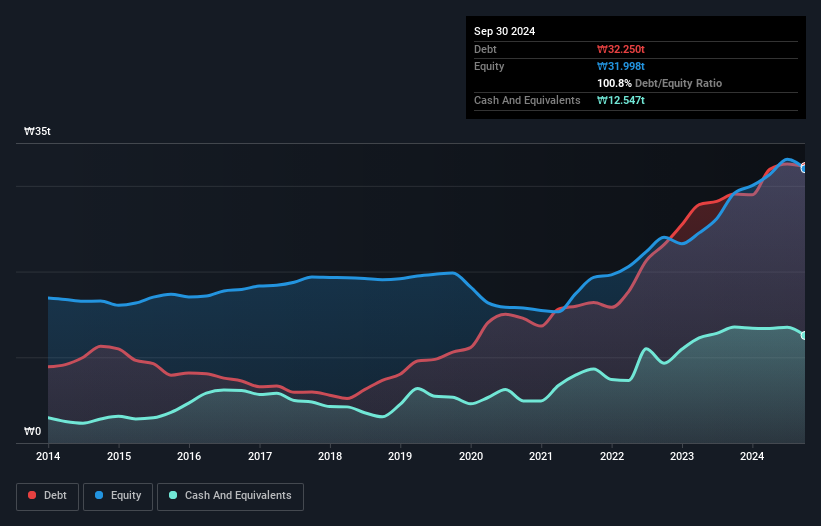
Some say volatility, rather than debt, is the best way to think about risk as an investor, but Warren Buffett famously said that 'Volatility is far from synonymous with risk.' So it seems the smart money knows that debt - which is usually involved in bankruptcies - is a very important factor, when you assess how risky a company is. As with many other companies SK Innovation Co., Ltd. (KRX:096770) makes use of debt. But the more important question is: how much risk is that debt creating?
What Risk Does Debt Bring?
Generally speaking, debt only becomes a real problem when a company can't easily pay it off, either by raising capital or with its own cash flow. In the worst case scenario, a company can go bankrupt if it cannot pay its creditors. However, a more common (but still painful) scenario is that it has to raise new equity capital at a low price, thus permanently diluting shareholders. Of course, plenty of companies use debt to fund growth, without any negative consequences. When we think about a company's use of debt, we first look at cash and debt together.
See our latest analysis for SK Innovation
What Is SK Innovation's Debt?
You can click the graphic below for the historical numbers, but it shows that as of September 2024 SK Innovation had ₩32t of debt, an increase on ₩29t, over one year. On the flip side, it has ₩13t in cash leading to net debt of about ₩20t.

How Healthy Is SK Innovation's Balance Sheet?
Zooming in on the latest balance sheet data, we can see that SK Innovation had liabilities of ₩30t due within 12 months and liabilities of ₩23t due beyond that. On the other hand, it had cash of ₩13t and ₩6.62t worth of receivables due within a year. So it has liabilities totalling ₩34t more than its cash and near-term receivables, combined.
This deficit casts a shadow over the ₩16t company, like a colossus towering over mere mortals. So we definitely think shareholders need to watch this one closely. At the end of the day, SK Innovation would probably need a major re-capitalization if its creditors were to demand repayment. When analysing debt levels, the balance sheet is the obvious place to start. But ultimately the future profitability of the business will decide if SK Innovation can strengthen its balance sheet over time. So if you're focused on the future you can check out this free report showing analyst profit forecasts.
In the last year SK Innovation had a loss before interest and tax, and actually shrunk its revenue by 2.7%, to ₩75t. That's not what we would hope to see.
Caveat Emptor
Importantly, SK Innovation had an earnings before interest and tax (EBIT) loss over the last year. Indeed, it lost ₩223b at the EBIT level. Considering that alongside the liabilities mentioned above make us nervous about the company. We'd want to see some strong near-term improvements before getting too interested in the stock. Not least because it had negative free cash flow of ₩7.5t over the last twelve months. That means it's on the risky side of things. There's no doubt that we learn most about debt from the balance sheet. However, not all investment risk resides within the balance sheet - far from it. For example - SK Innovation has 2 warning signs we think you should be aware of.
When all is said and done, sometimes its easier to focus on companies that don't even need debt. Readers can access a list of growth stocks with zero net debt 100% free, right now.
New: Manage All Your Stock Portfolios in One Place
We've created the ultimate portfolio companion for stock investors, and it's free.
• Connect an unlimited number of Portfolios and see your total in one currency
• Be alerted to new Warning Signs or Risks via email or mobile
• Track the Fair Value of your stocks
Have feedback on this article? Concerned about the content? Get in touch with us directly. Alternatively, email editorial-team (at) simplywallst.com.
This article by Simply Wall St is general in nature. We provide commentary based on historical data and analyst forecasts only using an unbiased methodology and our articles are not intended to be financial advice. It does not constitute a recommendation to buy or sell any stock, and does not take account of your objectives, or your financial situation. We aim to bring you long-term focused analysis driven by fundamental data. Note that our analysis may not factor in the latest price-sensitive company announcements or qualitative material. Simply Wall St has no position in any stocks mentioned.
About KOSE:A096770
SK Innovation
Engages in the production and sale of petroleum products, lubricants, and base oil in South Korea and internationally.
Good value slight.
Similar Companies
Market Insights
Community Narratives




